

The Central
Brooklyn neighborhoods of Crown and Prospect Heights are once again
connected to Bedford-Stuyvesant by this historic, 19th Century railroad
line.
Riding the
new Franklin Avenue Shuttle might be a bit
shocking to those of us who last rode the line during the '60s or '70s.
Having lived in Crown Heights during the mid-'60s as a youth it was—for me
(and my pals)—the beginning of the route to our adventures at Coney
Island.
|
The Franklin Avenue Line had been
demoted from mainline to branch line for only four years when this
1924 map was drawn. To see a large size current
track map |
|
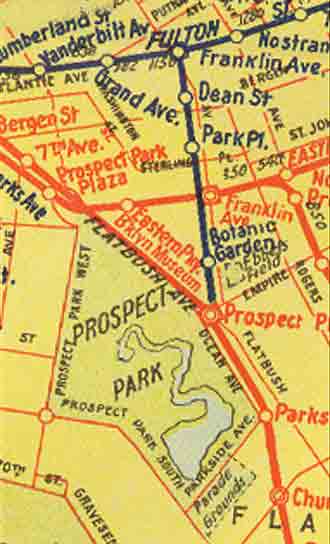 |
The date was Monday, October 13, and my trip started out at the grand and expansive (along with expensive) rebuilt Fulton-Franklin terminal station.
At approximately 8:30 a.m., a crowd of local curiosity seekers (and some subway buffs—guilty!) crowded the street-level fare control area. There, Brooklyn Borough President Howard Golden along with Assemblyman Al Vann, City Councilmember Mary Pinkett and MTA Chair E. Virgil Conway cut the ribbon at the Franklin Shuttle's northern-most terminal (Franklin Avenue). The new Franklin Avenue Shuttle was officially reopened to the public.
After the pomp and circumstance, the throng climbed—or rode the brand new escalator—to the platform level of Franklin-Fulton.
The New Terminal Station
I found the most altered parts of the Shuttle are the elevated area, beginning here to just south of Park Place station. The entire structure at the terminal has been re-configured: gone was the wooden "U" shaped platform that included the remaining Fulton El steel skeleton. In its place was a combined steel and concrete station.
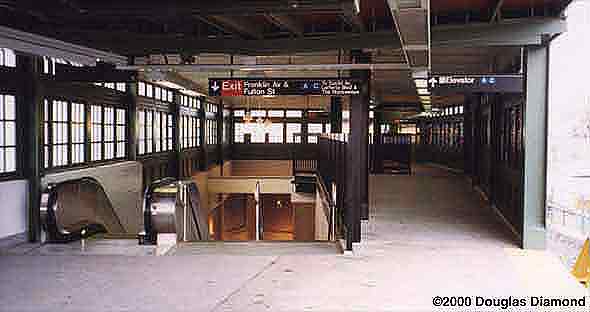
The New Entrance Facilities at Franklin Avenue and Fulton Street, as seen from the platform. In addition to the stairs and escalators seen here, the passageway at the right leads to elevators to the street and IND Fulton Street Line connections. Douglas Diamond photo
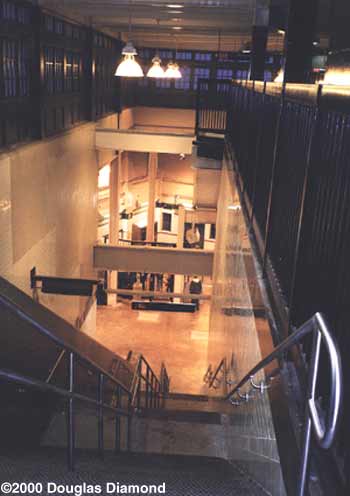 |
Looking down into the entrance
well, it would appear that the Franklin Avenue station has
been rebuilt in anticipation of much bigger crowds than can be
anticipated to use the shuttle any time soon. The generous entrance
area and amenities for boarding and transferring passengers are an
enormous contrast from prior arrangements. |
|
Two panels of the
stained-glass artwork installed at the new Franklin Avenue
terminal station. |
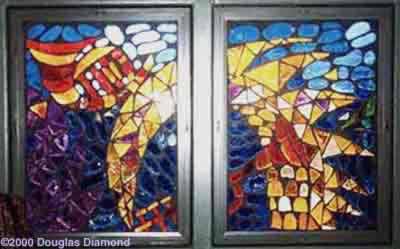 |
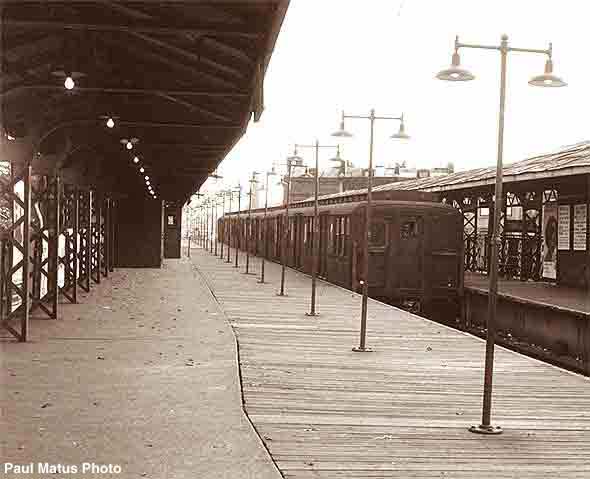
When Franklin Avenue station was reconstructed the
original elevated station, seen here in a 1965 view, was dismantled. Still
in fairly good shape here, it had deteriorated amazingly by the time the
Shuttle was closed for reconstruction in 1998. The wooden platform covers
the original northbound track, rails and crossties of which became visible
in later years when the wooden portion of the platform was dismantled.
This platform was used for exiting passengers; boarding passengers
used the platform opposite. Note the "bite" out of the concrete
platform in the foreground. This provided overhang space for elevated cars
turning onto the Fulton Street L in the days when Brighton trains still
used this terminal as a way station enroute to Park Row in Manhattan.
Paul Matus photo.
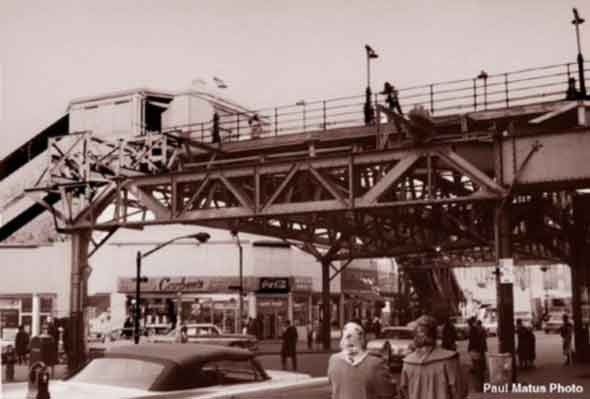
In another 1965 view, the old walkway between the
Franklin Shuttle (not visible at the right of the picture) enabled riders
to get to the City-bound IND Fulton Street Subway. This small piece of the
original Kings County L structure was decked over to the provide the
walkway. This was destroyed as part of the 1998-'99 rebuild. Paul
Matus photo.
|
1 |
The Third Rail and The Third Rail logo are trademarks of The Composing Stack Inc.
Return to The Third Rail Online Home
Return to
rapidtransit.net Home
Everything on this site is copyright © 2000 by The Composing
Stack Inc., except as otherwise noted.
Materials
with other copyrights are used by permission.
All
rights reserved
Last updated March 26, 2000